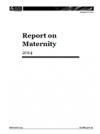This report describes
- the demographic profile of women giving birth (eg, age, ethnicity, deprivation) and selected antenatal factors (eg, BMI, smoking)
- events relating to labour and birth (eg, type of birth, interventions, place of birth)
- the demographic profile of live-born babies, their birthweight and gestation and care provided after birth.
Key Results
- 59,193 women gave birth and 59,494 babies were live-born.
- The birth rate in 2014 was 65.0 per 1000 females of reproductive age; the lowest since 2005.
- Birth rates for young women have decreased over the last decade while birth rates for older women have increased.
- Women giving birth were predominantly European, aged 25–34 years, residing in more deprived neighbourhoods, and had had at least one previous birth.
- Most women received primary maternity care from a midwife Lead Maternity Carer.
- Two of every three women registered with a Lead Maternity Carer did so within their first trimester of pregnancy; an increase from 2008 where half registered within the first trimester.
- Most women gave birth at a secondary or tertiary maternity facility.
- Home births were more common among women in their 40s, Māori women, and European women.
- Elective caesarean section rates have increased.
- One in every three women giving birth had a spontaneous vaginal birth without having an induced or augmented labour, an epidural or an episiotomy.
- More live-born babies were male than female.
- There was little change in average birthweight.
- Median gestation at birth was 39 weeks.
- Most babies were exclusively or fully breastfed.

